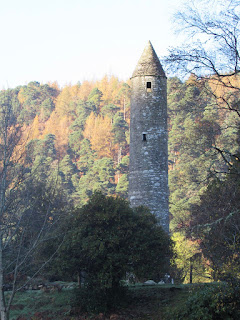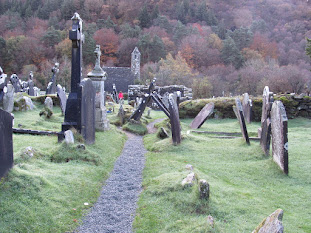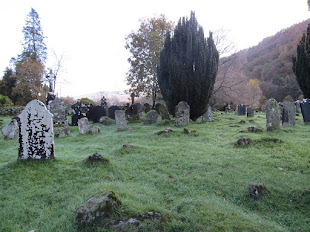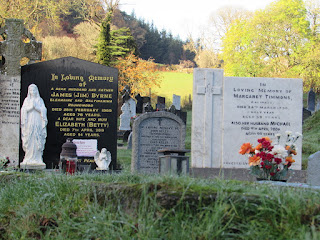One of the spookiest places I've ever visited is the old and very secluded grounds of the monastery at Glendalough--one of the most important in Ireland. This scene of the graveyard looks like something out of a horror movie. And yet, this place also felt very spiritual.
And no wonder. Glendalough has been a place of pilgrimage since the 6th
century when St. Kevin lived here as a hermit and ascetic who attracted followers and established a monastery there. Little is known for
certain about Kevin, but there are many stories and myths that continue to
fascinate and offer inspiration about him today. One is that he lived in a man-made cave, now known as Kevin's Bed. He lived in Nature and made friends with the birds and animals there. He wore animal skins, walked barefoot, and ate very little. Of course, he spent most of his time in prayer. He eventually became known as a great teacher and people from all around visited him seeking help and guidance. In his later years he presided over Glendalough and lived through prayer, fasting, and teaching. St. Kevin is one of the patron saints in the Diocese of Dublin. Eventually, Glendalough, with its seven churches, became one of the chief pilgrimage destinations in Ireland.
One of the stories of Kevin is his relationship with a blackbird where he held out his hand with trance-like stillness while the bird built a nest in it and layed her eggs. He then watched the eggs hatch and the chicks fledge. Kevin became a saint on December 9, 1903.
Round Tower

Because this area is so secluded, it is believed that the round tower was a marker to help direct pilgrims and other visitors to the monastery. It is quite remarkable that this tower still stands since the base underground is only a yard thick.
Gateway to the Sacred Grounds
Evidence of human activity in the valley possibly goes as far back as the Neolithic Period. Recent excavations have uncovered industrial activity that may be contemporary with St. Kevin’s reputed foundation of a ‘monastery’ around 600 AD. Glendalough is one of the most important medieval ecclesiastical landscapes in Ireland. Since the nineteenth century it has been one of Ireland’s premier tourist attractions.
Saints Peter and Paul Cathedral
The entrance to the cathedral (above) and the altar and sanctuary of the ancient Romanesque cathedral. Below is the nave with ancient gravestones implanted into the floor, a common practice in the UK churches.

Priests' House or Sacristy

Some people regard this building as the priests house as well as the sacristy of the Cathedral. Some people come here to touch the stones because they claim they have some healing power. I tried it and prayed for the health of my family and friends as well as my own health.


Church
One of the seven churches left in the Glendalough region with its roof still fully in tact. The interior shows some environmental wear.


Celtic Cross
The Celtic Cross illustrates the union of the pagan Nature religions with Christianity. The round part represents the sun, while the cross represents Christianity.Peter, our Irish guide from Dublin, explains the various sections of Glendalough. He said he finds this place one of the most inspiring in all of Ireland.
Graves
Some of the graves are hundreds of years old, so they "move" with the earth with all its lumps and depressions. Many graves are recent, however. The white substance on the stones are a type of moss that indicates that the area is free of pollution.


Holy Ground
 Glendalough is also known as Gleann-Dá-Locha (the valley of the two lakes).
Glendalough is also known as Gleann-Dá-Locha (the valley of the two lakes).

Resources
Glendalough Hermitage Centre -- https://glendaloughhermitage.ie/glendalough/
Monastic Ireland: Glendalough -- http://monastic.ie/history/glendalough/



















No comments:
Post a Comment